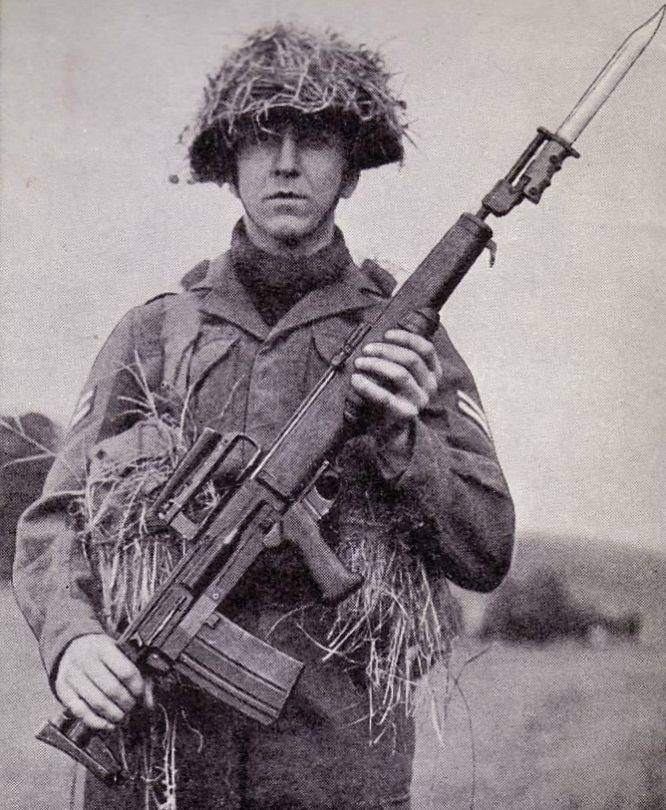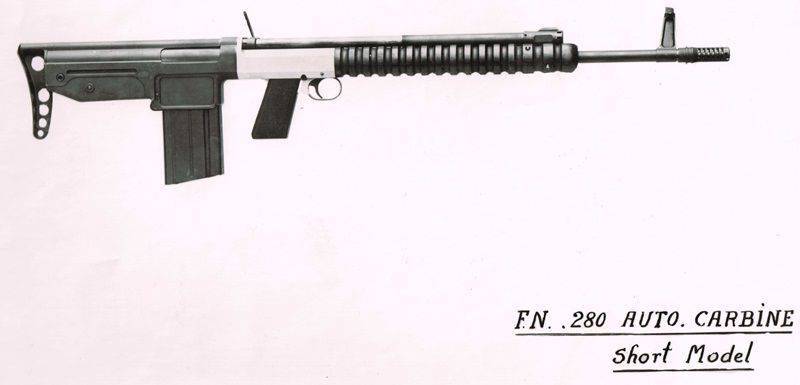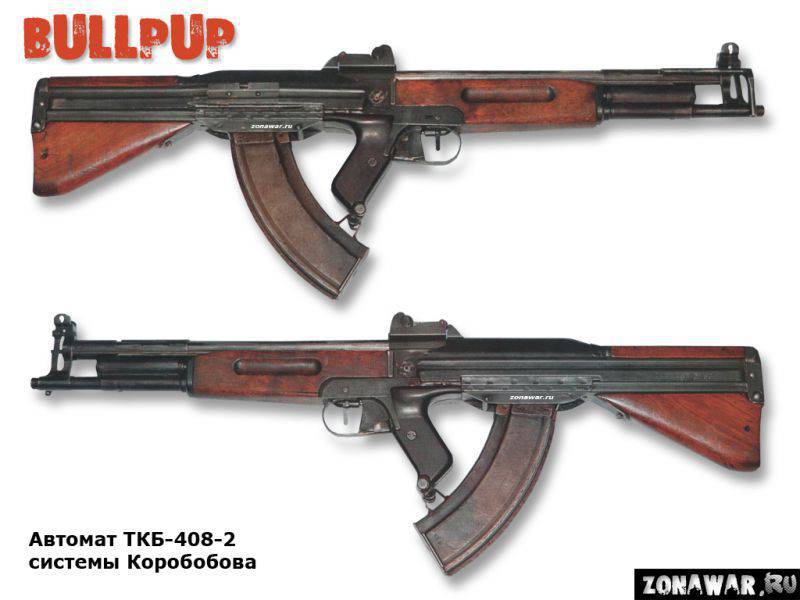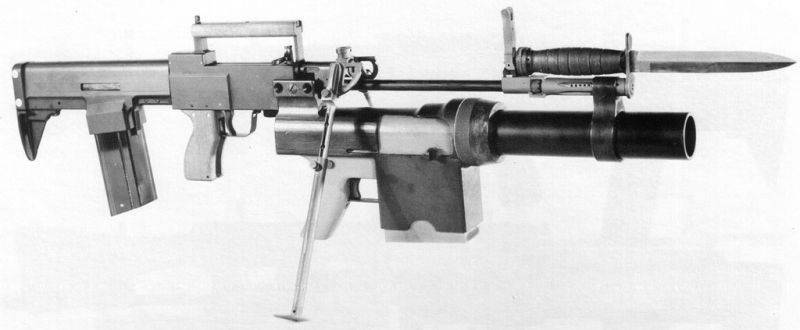Bullpup: from the first samples to the present day (part of 2)
As we wrote earlier, by the end of the Second World War in Great Britain seriously engaged in the development of small arms, made in the layout bullpup. Almost immediately after the end of the war in England, a decision was made on the need to re-equip the army from Lee-Enfield shop rifles with modern automatic weapons. It was about the machines, created under a specially designed intermediate cartridge. Such a cartridge in the UK created shortly after the end of the war, he had the metric designation 7x43 mm.
At the end of the 1940-ies, the British gunsmiths created three experienced automatic EM-1 and EM-2 automatic weapon systems developed by state-owned arsenals and BSA-280 developed by BSA Ltd. engineers for this cartridge. Of the three systems listed, only the latter had the traditional layout, and the EM-1 and EM-2 automata were built according to the bullpup layout. According to the test results, the best results were demonstrated by the Stefan Jensen machine EM-2. In 1951, this 7-mm machine gun was even formally adopted by the British army, receiving the designation “Rifle, Automatic, caliber .280, Number 9 Mark 1”.

Automation of the novelty was built on the basis of a gas exhaust engine with a long stroke of the gas piston. The piston and gas chamber were located above the barrel. The shutter had a cylindrical shape, the locking was carried out with the help of dilution of two lugs symmetrically located on the sides of the shutter, for cuts in the walls of the receiver. The locking assembly was similar to that of the German Gew.43 self-loading rifles or the locking knot deployed backwards to that used on the Soviet machine gun of the Degtyarev DP-27 design.
The manual safety device was located in the front part of the trigger guard, the translator of fire modes (from single to all) was made in the form of a transverse button and was located above the pistol grip. Pistol grip and handguard were made of wood. It is curious that the sighting device EM-2 included mounted on the integral handle used to carry weapons, optical sight and backup folding front sight and rear sight. The optical sight had a grid with marks for introducing the necessary corrections in firing range. Backup pillar was dioptric and made folding. He was on the left side of the handle for carrying the machine, the front sight was also foldable and was on the left side of the gas chamber.
However, due to the change of government in the country, the decision to adopt the EM-2 machine gun was revised only a couple of months later. This decision was canceled for reasons of unification of ammunition with American allies. At the same time, an attempt was made to remake the EM-2 machine for a larger and more powerful American cartridge 7.62x51 mm, but for several reasons it ended in failure. As a result, already in 1955, the British army finally received a self-loading rifle L1A1 SLR, developed for the cartridge 7.62x51 mm. This rifle was a variant of the very successful Belgian rifle FN FAL, but was made in the traditional layout.

It is worth noting here that a successful Belgian rifle could initially become just a weapon in the bullpup layout. In the early design stages of the FN FAL, designers from Belgium worked out their promising automatic machine for the English cartridge 7х43 mm in parallel in two configurations at the same time - the bullpup and the traditional one. Having stopped subsequently on the traditional. To argue with this decision today is meaningless, as the automatic rifle FN FAL today is one of the most common and recognized in the world. This automatic rifle is still widely used throughout the world, in various modifications it was in service with 90 countries of the world.
In parallel with the European designers, gunsmiths on the layout bullpup worked in the Soviet Union. The first experiments in this direction in our country began even before the Second World War, in particular, several anti-tank guns were created in this layout. And already in the 1945 year, after the decision was made to develop a new machine for the intermediate cartridge of the model 1943 of the year in the USSR, an experienced Korovin machine was sent for testing. However, this model for some reason could not pass the test. A little later, in 1947, a new competition was held, in which another bullpup TKB-408 designed by Gennady Korobov was presented. Then he also failed to pass the competition, which, as everyone knows, won the Kalashnikov assault rifle, built according to the classical layout.
The use of the Korobov bullpup layout made it possible to reduce the length of the machine by approximately 200 mm, while maintaining the normal length of the barrel, which was very important for the infantrymen. However, its development at that time for the Soviet arms school was quite new. In addition, the designer summed up the execution. The Korobov TKB-408 submachine gun did not satisfy the requirements of the military either in terms of survivability or accuracy of fire. He dropped out of the competition only after 5000 shot at shots due to the low survivability of the bolt and receiver, as well as a large number of delays when shooting. At the same time, the failure with this model did not turn Korobov away from the chosen path, and in the future he continued his experiments with this scheme.
The layout of the bullpup and the Americans, who at the end of the 1940-s also presented their new developments, did not leave without attention. In particular, in 1949, in the USA, an experienced 7,62-mm T31 machine designed by John Garand was tested. At the same time, apparently, the US military did not seriously consider this development, and in 1957, the M14 rifle, which had a classic layout, was adopted by the American army.
In 1950, the French also showed their interest in the bullpup layout. A feature of most of the works of the French gunsmiths of that period was that a whole series of advanced systems of advanced automatic rifles and self-loading rifles, developed at state-owned weapons factories, were created in two versions at once - the traditional one and the bullpup. Despite this, the French also decided not to run ahead of the locomotive, rightly remembering that the best is the enemy of the good. In 1956, they adopted the rather conservative self-loading rifle MAS 49 / 56, which was distinguished by its traditional layout and was built on pre-war French designs.
As a result of all these experiments, by the end of the 1950s, most of the armies of the two main military blocs of the planet, NATO and the ATS, were able to rearm themselves with new rifle weapon systems, while all machine guns and rifles were based on the traditional layout. Despite this, work on the design of automatic small arms in the bullpup layout was continued, which was largely dictated by the increasing mechanization of the ground forces. The deployment of soldiers in the close compartments of infantry fighting vehicles and armored personnel carriers and the landing helicopters that were just emerging demanded work to reduce the size of the infantry’s weapons while maintaining the ability to fire directly from the combat compartment. At the same time, the folding butt could not always solve the problems.
In the Soviet Union, even despite the fact of adopting a successful and relatively compact Kalashnikov machine gun, the work on the machine guns in the bullpup scheme also continued. At the beginning of 1960-s, Gennady Korobov, already mentioned above, presented his new TKB-022 submachine gun, which at that time was distinguished by a number of advanced engineering solutions, including the extensive use of plastic in the weapon design, as well as the release of spent cartridges ahead, which not only allowed safe firing from the left shoulder, but also excluded the possibility of hitting spent cartridges in neighboring infantrymen, especially when firing from the close compartment of infantry fighting vehicles or armored personnel carriers. Another difference TKB-022 was a very high ratio of the length of the barrel of the machine to the total length of the weapon. For this, the designer used a short vertical wedge gate, and the filling of the cartridge and then the extraction of the spent cartridge was carried out using a separate part that was connected to the gas piston rod. As a result, TKB-022 was created in a number of options, with the latest models being created for the new 5,6 mm cartridge. But before the series, this weapon never came.
The TKB-022 assault rifle used vapor-gas automatic with an annular gas piston that was located around the barrel. The barrel was locked using a vertical wedge slide, which, on the one hand, allowed Korobov to significantly reduce the length of the receiver, and on the other hand, it required the introduction of a dispenser / extractor into the design of the automaton. It was a U-shaped piece, moving in the horizontal plane back and forth. She was responsible for sending the cartridge into the chamber and removing the spent cartridge case from the barrel, as well as sending the sleeve into the outputting tube above the barrel of the machine gun, through which the sleeve falls into the front part of the weapon, where it falls freely at the base of the front sight.
In general, all modifications of TKB-022 Korobov remained only in the form of prototypes, which was due to both quite objective reasons (for example, the "survivability" of the plastic case during long-term operation in difficult conditions of use and storage and the shift of the center of gravity to the back of the weapon ), and the reasons for the subjective nature (the military leadership of the USSR, which was responsible for adopting weapons, was very conservative and did not welcome radical changes in small arms). Then a similar fate befell the TKB-011 machine gun, designed by Afanasyev. This machine, which was tentatively created in the 1963 year, also had a plastic case, and the spent cartridges were thrown forward-right through a special window located in the wall of the receiver.
At about the same time period, closer to the middle of the 1960s, the designer Konstantinov from Kovrov also seriously engaged in bullpaps. One of his early designs, the 7,62-mm CA-01, had a very unusual arrangement, in which the pistol grip was located above the receiver. The designer came to such a decision in an attempt to increase the combat characteristics of the weapon (mainly the accuracy of fire by bursts, especially from unstable situations). But, obviously, this layout was perceived as too radical, and the CA-001 prototype, created two years later, differed in the usual two-handle layout for the bullpup — the front (auxiliary) and the rear. Like all Tula systems having the TKB index, the automata proposed by Konstantinov also could not go beyond the experimental stage.
In the first half of 1960, the bullpaps developed in the United States, where as part of a very ambitious, long and expensive SPIW program, which turned out to be (largely predictably) unsuccessful, the American army attempted to create an “individual special purpose weapon” (Special Purpose Individual Weapon). ). The customer saw in this image a multipurpose weapon that could hit both areal targets (using a multiply-loaded grenade launcher) and point targets (using automatic fire using small-caliber swept bullets). One of the main contenders for victory in this program was the automatic machine of the Springfield arsenal. The first model of this weapon was distinguished by its modular design, which made it very easy to assemble both the bulpap and the weapons of traditional layout from the base weapon. In the future, it was decided to abandon the modularity, and by the year 1965 the weapon called Springfield SPIW was presented in hardware. It was a rather long and angular bullpup, characterized by the presence of a tandem store on 60 cartridges. Due to numerous problems both with unrealistic tactical and technical requirements, and with swept ammunition, not a single SPIW sample was able to reach mass production.
The latest known patterns of bullpaps of this time period include “Individual Multipurpose Weapon (IMP-221), which was also known as the“ GUU-4 / P submachine gun. ” This is a compact bullpap that was designed for a relatively powerful type of .221 caliber cartridges (5.56mm). It was developed as a personal weapon of self-defense. They planned to arm the pilots and crews of helicopters and airplanes of the American Air Force. GUU-4 / P bullpup was supposed to fire from a pistol, that is, from one hand, for this reason there was no stock on the model. In order for the magazine located behind the fire control handle not to interfere with the “pistol” grip of the weapon, the entire body could rotate relative to the handle around the barrel axis to the right or left approximately 40 degrees, which was a very interesting decision. The prototype GUU-4 / P bullpup in 1969 was produced by Colt, but after conducting a series of tests, the US Air Force lost interest in this project and didn’t go into mass production, like the other models described above. However, ahead of the layout of the bullpup was waiting for a blessed time, but this is the topic for the third article.
Information sources:
https://www.all4shooters.com/ru/glavnaya/tekhnika/2015-statyi/Bullpap-chetvert-veka-eksperimentov-1945-1970
http://www.e-reading.club/chapter.php/133025/7/Popenker_-_Shturmovye_vintovki_mira.html
http://weapon.at.ua/load/321-1-0-822
http://weapon.at.ua/load/321-1-0-825
Open source materials



Information